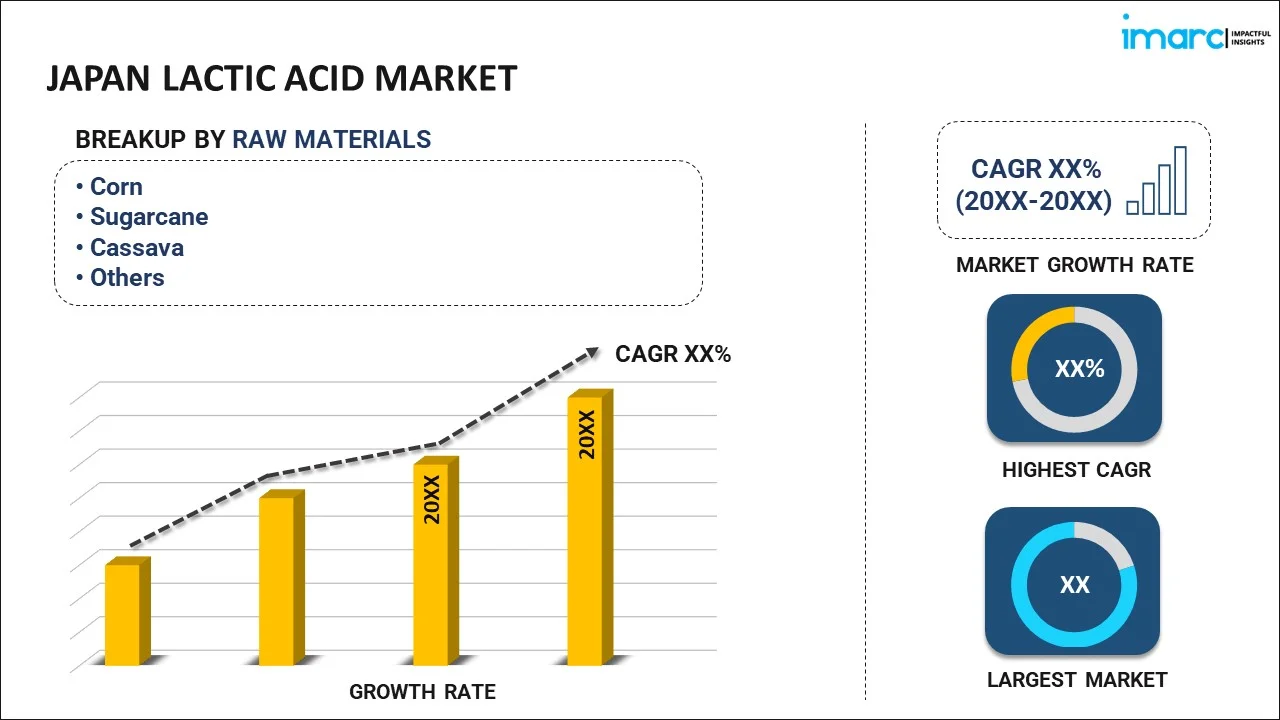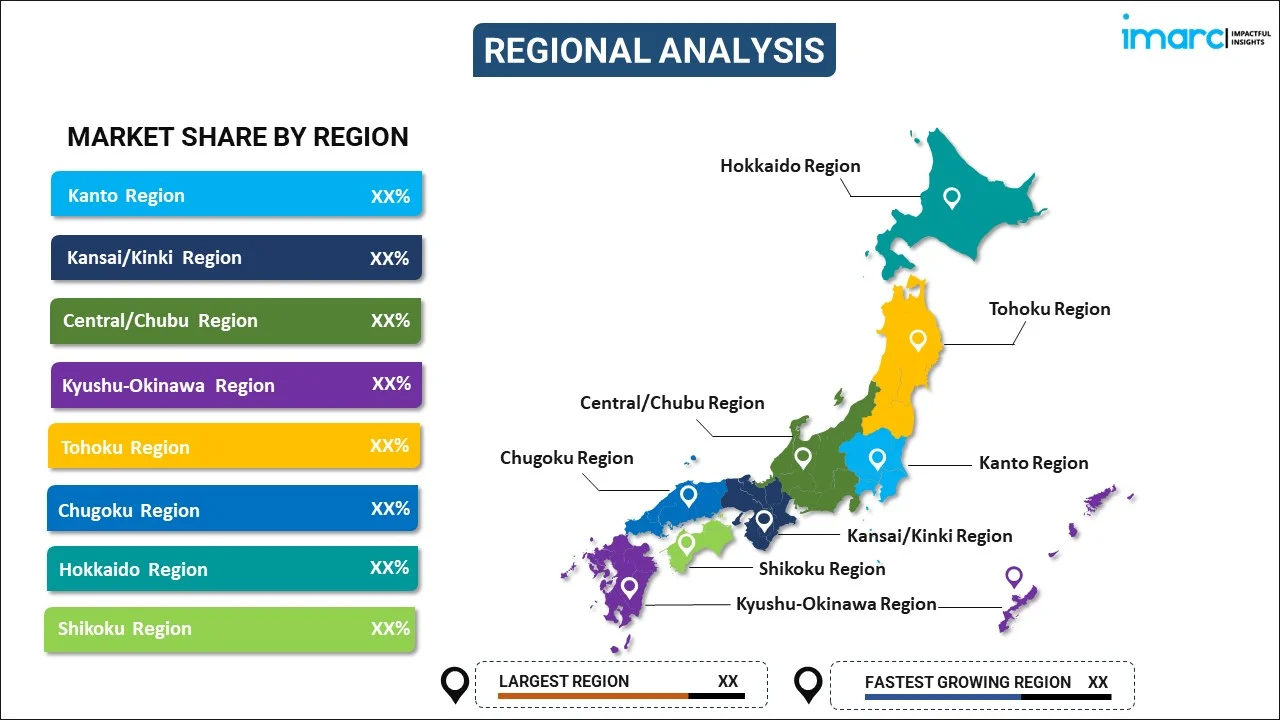
Japan Lactic Acid Market Report by Raw Material (Corn, Sugarcane, Cassava, and Others), Form (Liquid, Solid), Application (Industrial, Food and Beverages, Pharmaceuticals, Personal Care, Polylactic Acid (PLA), and Others), and Region 2025-2033
Market Overview:
Japan lactic acid market size reached USD 77.3 Million in 2024. Looking forward, IMARC Group expects the market to reach USD 140.5 Million by 2033, exhibiting a growth rate (CAGR) of 6.9% during 2025-2033. The lactic acid market is experiencing notable expansion due to several key factors, including substantial growth within the food and beverage (F&B) sector, increased utilization of the product in the cosmetic and personal care industry, and extensive research and development (R&D) activities.
|
Report Attribute
|
Key Statistics
|
|---|---|
|
Base Year
|
2024 |
|
Forecast Years
|
2025-2033 |
|
Historical Years
|
2019-2024
|
| Market Size in 2024 | USD 77.3 Million |
| Market Forecast in 2033 | USD 140.5 Million |
| Market Growth Rate (2025-2033) | 6.9% |
Lactic acid (C3H6O3) is an organic compound that is clear and soluble in water. It occurs naturally in muscles and red blood cells. Commercially, it is derived from various raw materials, including cornstarch, sugarcane, molasses, whey, cassava, and lignocellulosic biomass. Lactic acid finds widespread application in various industries such as food and beverages, pharmaceuticals, biodegradable plastics, textiles, detergents, and personal care products. Its functions include regulating pH levels, extending shelf life, and improving the texture, flavor, and stability of products. Furthermore, lactic acid is environmentally friendly and biodegradable, contributing to reduced ecological impacts and sustainability efforts.
Japan Lactic Acid Market Trends:
The Japan lactic acid market is experiencing robust growth, driven by a multitude of factors that align with evolving industrial and consumer trends. A prominent driver is the increasing utilization of lactic acid in the pharmaceutical industry for various applications, including the production of biodegradable implants, tissue engineering scaffolds, and advanced drug delivery systems like hydrogels and nanoparticles. This diversification of product applications in healthcare contributes significantly to market expansion. Additionally, lactic acid is gaining traction as an excipient in drug formulations, where it enhances solubility and helps maintain optimal pH levels. This application adds to the market's growth momentum. The textile industry is also a significant contributor to market growth, with lactic acid finding roles in enhancing fiber properties, improving dyeing and printing processes, preventing microbial growth, and serving as a solution for removing impurities and contaminants from textile wastewater. Moreover, lactic acid has established itself in the agriculture sector, where it serves as a Biostimulants, soil conditioner, and promoter of plant growth, further contributing to market expansion. It is also utilized in animal feed as an acidifier and preservative, promoting beneficial gut bacteria and improving nutrient absorption. Other factors such as increasing demand for environmentally friendly products, easy availability of lactic acid through online retail platforms, and emerging health and wellness trends among consumers are expected to further drive the growth of the Japan lactic acid market in the coming years.
Japan Lactic Acid Market Segmentation:
IMARC Group provides an analysis of the key trends in each segment of the market, along with forecasts at the country level for 2025-2033. Our report has categorized the market based on raw material, form, and application.
Raw Material Insights:

- Corn
- Sugarcane
- Cassava
- Others
The report has provided a detailed breakup and analysis of the market based on the raw material. This includes corn, sugarcane, cassava, and others.
Form Insights:
- Liquid
- Solid
A detailed breakup and analysis of the market based on the form have also been provided in the report. This includes liquid and solid.
Application Insights:
- Industrial
- Food and Beverages
- Pharmaceuticals
- Personal Care
- Polylactic Acid (PLA)
- Others
The report has provided a detailed breakup and analysis of the market based on the application. This includes Industrial, food and beverages, pharmaceuticals, personal care, polylactic acid (PLA), and others.
Regional Insights:

- Kanto Region
- Kansai/Kinki Region
- Central/ Chubu Region
- Kyushu-Okinawa Region
- Tohoku Region
- Chugoku Region
- Hokkaido Region
- Shikoku Region
The report has also provided a comprehensive analysis of all the major regional markets, which include Kanto Region, Kansai/Kinki Region, Central/ Chubu Region, Kyushu-Okinawa Region, Tohoku Region, Chugoku Region, Hokkaido Region, and Shikoku Region.
Competitive Landscape:
The market research report has also provided a comprehensive analysis of the competitive landscape. Competitive analysis such as market structure, key player positioning, top winning strategies, competitive dashboard, and company evaluation quadrant has been covered in the report. Also, detailed profiles of all major companies have been provided. Some of the key players include:
- Galactic
- Kameda Seika Co. Ltd.
- Musashino Chemical Laboratory Ltd.
(Please note that this is only a partial list of the key players, and the complete list is provided in the report.)
Japan Lactic Acid Market Report Coverage:
| Report Features | Details |
|---|---|
| Base Year of the Analysis | 2024 |
| Historical Period | 2019-2024 |
| Forecast Period | 2025-2033 |
| Units | Million USD |
| Scope of the Report | Exploration of Historical Trends and Market Outlook, Industry Catalysts and Challenges, Segment-Wise Historical and Future Market Assessment:
|
| Raw Materials Covered | Corn, Sugarcane, Cassava, Others |
| Forms Covered | Liquid, Solid |
| Applications Covered | Industrial, Food and Beverages, Pharmaceuticals, Personal Care, Polylactic Acid (PLA), Others |
| Regions Covered | Kanto Region, Kansai/Kinki Region, Central/ Chubu Region, Kyushu-Okinawa Region, Tohoku Region, Chugoku Region, Hokkaido Region, Shikoku Region |
| Companies Covered | Galactic, Kameda Seika Co. Ltd., Musashino Chemical Laboratory Ltd., etc, |
| Customization Scope | 10% Free Customization |
| Post-Sale Analyst Support | 10-12 Weeks |
| Delivery Format | PDF and Excel through Email (We can also provide the editable version of the report in PPT/Word format on special request) |
Key Questions Answered in This Report:
- How has the Japan lactic acid market performed so far and how will it perform in the coming years?
- What has been the impact of COVID-19 on the Japan lactic acid market?
- What is the breakup of the Japan lactic acid market on the basis of raw material?
- What is the breakup of the Japan lactic acid market on the basis of form?
- What is the breakup of the Japan lactic acid market on the basis of application?
- What are the various stages in the value chain of the Japan lactic acid market?
- What are the key driving factors and challenges in the Japan lactic acid?
- What is the structure of the Japan lactic acid market and who are the key players?
- What is the degree of competition in the Japan lactic acid market?
Key Benefits for Stakeholders:
- IMARC’s industry report offers a comprehensive quantitative analysis of various market segments, historical and current market trends, market forecasts, and dynamics of the Japan lactic acid market from 2019-2033.
- The research report provides the latest information on the market drivers, challenges, and opportunities in the Japan lactic acid market.
- Porter's five forces analysis assist stakeholders in assessing the impact of new entrants, competitive rivalry, supplier power, buyer power, and the threat of substitution. It helps stakeholders to analyze the level of competition within the Japan lactic acid industry and its attractiveness.
- Competitive landscape allows stakeholders to understand their competitive environment and provides an insight into the current positions of key players in the market.
Need more help?
- Speak to our experienced analysts for insights on the current market scenarios.
- Include additional segments and countries to customize the report as per your requirement.
- Gain an unparalleled competitive advantage in your domain by understanding how to utilize the report and positively impacting your operations and revenue.
- For further assistance, please connect with our analysts.
 Inquire Before Buying
Inquire Before Buying
 Speak to an Analyst
Speak to an Analyst
 Request Brochure
Request Brochure
 Request Customization
Request Customization




.webp)




.webp)












